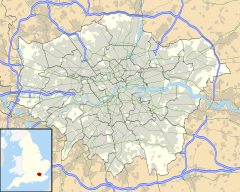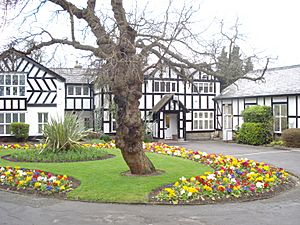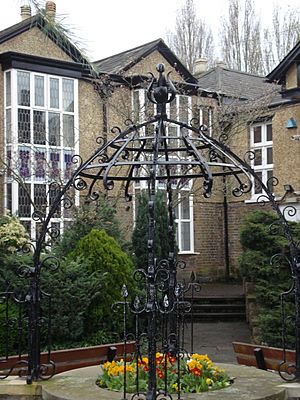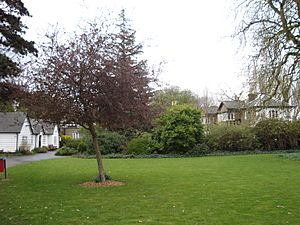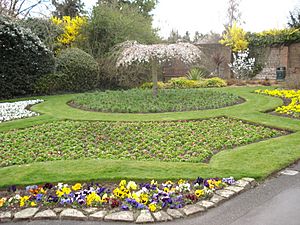Sudbury, London facts for kids
Quick facts for kids Sudbury |
|
|---|---|
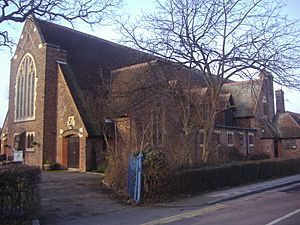 St Andrew's Church |
|
| Population | 14,950 (2011 Census. Ward) |
| OS grid reference | TQ165852 |
| London borough | |
| Ceremonial county | Greater London |
| Region | |
| Country | England |
| Sovereign state | United Kingdom |
| Post town | WEMBLEY |
| Postcode district | HA0 |
| Post town | HARROW |
| Postcode district | HA1 |
| Dialling code | 020 |
| Police | Metropolitan |
| Fire | London |
| Ambulance | London |
| EU Parliament | London |
| UK Parliament |
|
| London Assembly |
|
Sudbury is a lively area in northwest London, United Kingdom. It's a part of the Brent area. You can find it just west of Wembley Central.
Sudbury has a long history. It used to be a much larger area. Much of the land was once open fields called Sudbury Common. Today, it's a green and friendly place to live. Many parts of Sudbury were owned by the Barham family. Their name is still seen on local places like Barham School and Barham Park.
Sudbury is surrounded by other London areas. To its east is Wembley, and to the north is North Wembley. To the west, you'll find Sudbury Hill. South of Sudbury is North Greenford, which is in the London Borough of Ealing. Historically, Sudbury was part of the county of Middlesex.
Contents
A Journey Through Sudbury's Past
How Sudbury Grew
Sudbury was once a small village in the larger area of Harrow. It was part of a group of ten small settlements. The main road to London and the famous Harrow School helped Sudbury grow. Sir John Lyon, who founded Harrow School, also helped support the area.
The first train station in Sudbury opened in 1842. It was first called "Sudbury station." Later, in 1882, its name changed to "Sudbury and Wembley." Then, in 1910, it became "Wembley for Sudbury." Finally, in 1948, it was renamed "Wembley Central." That's the name it still has today!
Important People and Businesses
During the 1800s, two wealthy sisters, the Copland Sisters, lived in Sudbury. They were very generous. They asked a famous architect, Sir George Gilbert Scott, to build the Church of St John in 1846. This church marks the eastern edge of Sudbury.
Later, the Barham family owned much of the land. They ran the Express Dairy Company Limited. This company was very important! It was the first British dairy to use glass milk bottles. It also used special tanks to carry huge amounts of milk by train into London every night. The Express Dairy Company was also one of the first to use pasteurisation to make milk safe. They even supplied milk to Queen Victoria! The owner, George Barham Sr., was made a knight in 1904 for his work.
Sudbury in Modern Times
George Barham's son, Titus Barham, passed away in 1937. He left a lot of land for the public to enjoy. His large home in Barham Park was taken down in 1956. Many of the old farmlands were used for building houses between the two World Wars.
Sudbury started to become a town when railways arrived in the late 1800s. More and more people wanted to live there. So, many new homes were built. Even with all the building, Sudbury remains a fairly green area. This is because of careful planning rules. In 1928, land was set aside for the Vale Farm sports fields. There has been a swimming pool there since 1932.
Parks and Fun Things to Do
Barham Park is a lovely garden that dates back to the 1700s. You can still see the old foundations of Sudbury Lodge, which was once the home of George Barham. The park has beautiful flowers, three ponds, and a large play area for kids. There's also a war memorial there. A historic building called Crabb's House is also in the park. It's now used as a library.
Sports in Sudbury
Sudbury has a strong sports history. The London Wasps rugby team used to play here, starting in 1923. They later moved to other places. The old rugby ground in Sudbury is now used for housing.
You can find a large swimming pool, outdoor tennis courts, and cricket pitches at Vale Farm. There are also AstroTurf pitches and a sports complex. This complex is the home ground for Wembley F.C., a local football team. It has a stadium that can hold 2,000 people. Other sports clubs in Sudbury include Sudbury Golf Club and Sudbury Squash and Tennis Club.
The Lyons' Sports Club in Sudbury hosted the field hockey games for the 1948 Summer Olympics. How cool is that!
Old Buildings to See
In the 1800s, Sudbury was mostly open fields with a few farmhouses and large homes. Some of these old buildings are still standing today. One example is Hundred Elms Farm. It's now a residential care home, but the building itself is well kept.
Places of Worship
Sudbury has several churches. Sudbury Methodist Church is located near Butlers Green. Further along Harrow Road, you'll find St. Andrew's Church of England, St. George's Catholic Church, and the Church of St. John the Evangelist. St George's is a special building, listed for its historical importance.
St Andrew's Church started as a small mission church in 1904. A new, larger church was built and opened in 1926. This church is also a listed building. The Church of St John was designed by Gilbert Scott and built in the 1800s. It has been extended several times. This church has been carefully repaired and saved for future generations to enjoy.
Getting Around Sudbury
Nearby Areas
 |
South Harrow | Harrow | North Wembley |  |
| Sudbury Hill | Wembley Central | |||
| Greenford | Perivale | Alperton |
Underground Trains
- Sudbury Town Station, on the Piccadilly line
- Sudbury Hill Station, on the Piccadilly line
Overground Trains
- Sudbury & Harrow Road Station, on Chiltern Railways
- Sudbury Hill Harrow Station, on Chiltern Railways
Main Roads
- A404 (Harrow Road, Wembley)
- A4005 (Bridgewater Road & Harrow Road, Harrow)
- A4127 (Greenford Road & Sudbury Court Drive)
Buses
- 18 (Euston to Sudbury Swan)
- 182 (Brent Cross to Harrow Weald)
- 92 (Ealing hospital to Brent Park IKEA)
- H17 (Wembley Central to Harrow Bus Station)
- 245 (Golders Green to Alperton Sainsbury's)
Images for kids


